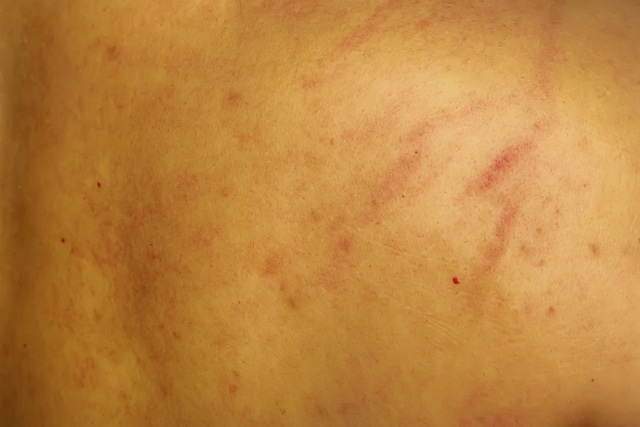Bartonella, What it is and it’s Symptoms
Bartonella is a tick-borne infection. Ticks that carry Lyme disease may also carry the co-infection Bartonella. Bartonella is composed of gram-negative, aerobic bacteria. It is an intracellular organism that multiplies in red blood cells. Along with ticks, Bartonella is commonly carried in cats which is why Bartonella is one of the reasons why this infection is known as cat-scratch disease. An intriguing aspect of this infection is its potential connection to skin rashes that resemble stretch marks.
While rashes that resemble stretch marks or scratches from a cat, are one of the tell tale signs for detecting Bartonella, there are various other symptoms that individuals suffer from while battling this infection. These symptoms include swollen lymph nodes, severe pain in the tibia and soles, bladder issues, vertigo, ear pain, sore throat, anorexia, psychiatric symptoms, and an unusual streaked rash.1 Oftentimes Bartonella is suspected when neurological symptoms are out of proportion to general symptoms.

Differences Between Lyme Rash and Bartonella Rash
With Lyme disease individuals may present an erythema migrans (EM), which specifically means “expanding rash” and is thought of as the hallmark sign of infection with B. burgdorferi. While many associate a Lyme rash with the bulls-eye, this is not the definition of an EM. An EM is defined as an expanding round rash of at least 2.5in. The rash can take many forms, and may have a raised bump in the middle. This rash may also be itchy or warm, and can have a bluish cast like a bruise.2 In contrast to the Bartonella rash, which can be similar in color, it is not round and instead is a linear pattern that looks like stretch marks or cat scratches.
Understanding Bartonella Infection and its Rash
Stretch marks, also known as striae, are a common skin concern that many people experience throughout their life. They often appear due to rapid changes in body size, such as during pregnancy, growth spurts, or sudden weight gain or loss. However, the Bartonella rash can also resemble stretch-marks. This rash should be on a dermatologist radar when comparing the similarities between the rash from the infection and actual stretch marks.

Bartonella Rash: An Unusual Presentation
The Bartonella rash can take on a distinctive appearance that has led to looking very similar to stretch marks. This rash typically presents as long, red or purplish streaks on the skin. The resemblance to stretch marks is essentially due to the linear pattern of the rash, which may raise questions about the underlying causes and potential misdiagnosis. The image above displays the bartonella stretch mark but to see more clear images click here.
Key Differences Between Bartonella Rash and Stretch Marks
While there are commonalities in appearance between Bartonella rash and stretch marks, it’s important to highlight the specific differences that set them apart.
1. Underlying Causes
- Bartonella Rash: This rash is a result of a bacterial infection caused by Bartonella species. It’s usually contracted through tick bites, cat scratches or bites that break the skin, or exposure to fleas.
- Stretch Marks: Stretch marks occur when the skin stretches in a short period of time due to changes in body size, leading to the breakdown of collagen and elastin fibers in the dermis.
2. Distribution and Pattern
- Bartonella Rash: The rash often appears in a linear or streak-like pattern. It can be mistaken for scratch marks due to its appearance, but it’s often more widespread and not restricted to areas of scratching.
- Stretch Marks: These marks can appear in various areas of the body where rapid stretching occurs. These areas can include the abdomen, thighs, butt, and breasts. It is not uncommon for them to have a more irregular and scattered pattern.
3. Color and Texture
- Bartonella Rash: The rash may initially be red or purplish, similar to fresh stretch marks. However, it can gradually become more linear and lighter in color overtime.
- Stretch Marks: Stretch marks can vary in color, from pink, red, purple, or silvery-white. They are often slightly depressed and have a different texture compared to surrounding skin.
4. Associated Symptoms
- Bartonella Rash: Bartonella infections can cause a host of symptoms, including fever, fatigue, headaches, muscle aches, bladder pressure, foot and/or heel pain, vertigo, and psychiatric symptoms in addition to the rash.
- Stretch Marks: Stretch marks themselves are not usually associated with any symptoms, but their presence might indicate significant changes in body size or hormonal fluctuations.
The Diagnostic Challenge
Distinguishing between Bartonella rash and stretch marks can be difficult, especially given the similarities in their appearance. Misdiagnosis can lead to delayed treatment in the case of Bartonella infection or unnecessary concern in the case of harmless stretch marks.
Seeking Medical Advice
If you notice any unusual skin changes, whether they resemble stretch marks or not, it is encouraged to seek medical advice. A Lyme Literate physician can help in assisting with an accurate diagnosis and recommend appropriate treatments or management strategies.
At The Lyme Specialist, when we see rashes that could be indicative of Bartonella, we will oftentimes test the individual at reputable laboratories that specialize in testing for tick-borne infections. Some laboratories that we would look into would be Galaxy Diagnostics, Vibrant Wellness, IGeneX, DNA Connexions, Fry Laboratories, and Armin Labs. We would also go through their medical history, and possible past encounters with ticks and cats.
In our Practice we have found that it is not uncommon for Veterinarians to be diagnosed with Bartonella, as they constantly come in contact with cats. “A 2014 study published by researchers at Duke University and North Carolina State University found DNA from at least one Bartonella species in 28 percent of veterinary workers compared to none in the control group.”3
We’ve also found that individuals with Lyme disease, who have cats as pets are more susceptible to be infected with Bartonella through the scratch or bite of their cat due to their compromised immune system. We would encourage cat owners to have their pet tested and treated if their pet did come out positive with Bartonella. Galaxy Diagnostics is one of the most reputable laboratories for testing Bartonella not only for humans but also for animals. You can find a link to information on their testing here: https://www.galaxydx.com/animal-health-testing/.
Conclusion
The resemblance between Bartonella rash and stretch marks highlights the complex nature of dermatology and tick-borne infections. While their appearance might be similar at first glance, the underlying causes, distribution, and associated symptoms differ significantly. If you suspect you have a Bartonella infection or are concerned about any skin changes, reaching out to a Lyme Specialist is the best course of action. Whether it’s a bacterial infection or a natural result of the body’s changes, taking the appropriate actions sooner rather than later could be the difference between receiving the proper treatment and preventing the development of a chronic illness that is much more difficult to treat as time goes on.
Citations:



